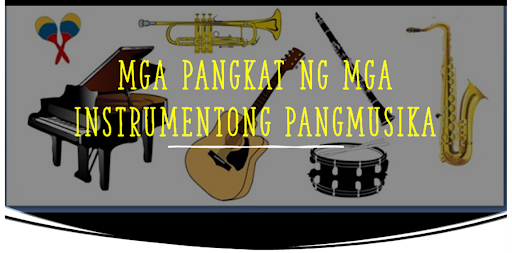(lenzchiofficial.blogspot.com)
Ang mga instrumentong pangmusika
ay maaaring mahati sa iba't ibang pangkat batay sa kanilang katangian,
paggamit, at pagkakasama-sama. Narito ang ilan sa mga pangkat ng mga instrumentong
pangmusika:
String Instruments o mga Instrumentong de Kwerdas
Ito
ay pangkat ng mga instrumentong ginagamitan ng mga string o kwerdas upang
mag-produce ng tunog. Kasama dito ang gitara, violin, cello, bass, at iba pang
mga instrumentong pang-string.
Ang
mga string instruments o mga instrumentong de kwerdas ay kasama sa
pinakapopular na pangkat ng mga instrumentong pangmusika. Ang mga ito ay
kinabibilangan ng gitara, biyolin, cello, double bass, at iba pa. Ang mga
string instruments ay kilala sa kanilang tunog na malambot, romantiko, at
nagbibigay ng emosyong mayroong texture at kakaibang kalinawan.
Mga
Uri ng mga Instrumentong de Kwerdas:
Narito
ang ilan sa mga halimbawa ng mga instrumentong de kwerdas:
1. Gitara
Isa sa
pinakapopular na string instrument na ginagamit sa mga banda, ensemble, at solo
performances. May iba't ibang uri ng gitara tulad ng acoustic, electric, at
bass guitar. Ang mga sikat na gitaraista ay sina Jimi Hendrix, Eric Clapton, at
Slash.
2. Biyolin
Isa sa mga classical string instrument na
kilala sa kanyang mataas na tono at maamong tunog. Karaniwang ginagamit ito sa
orchestra at chamber music. Maraming sikat na biyolinista tulad ni Niccolò
Paganini, Fritz Kreisler, at Vanessa-Mae.
3. Cello
Isa sa
malalaking string instrument na may malalim na tono. Karaniwang ginagamit ito
sa orchestra at chamber music. Maraming sikat na cellist tulad ni Yo-Yo Ma,
Jacqueline du Pré, at Pablo Casals.
4. Double Bass
Isa sa pinakamalaking string instrument na
ginagamit sa orchestra at jazz music. Mayroon itong malalim na tono na
nagbibigay ng lakas sa orkestra. Maraming sikat na double bassist tulad ni
Charles Mingus, Ray Brown, at Edgar Meyer.
5. Harp
Isang
string instrument na mayroong mga pins sa bawat string upang makapagbigay ng
iba't ibang tono. Karaniwang ginagamit ito sa classical music. Maraming sikat
na harpist tulad ni Nicanor Abelardo, Marcel Grandjany, at Nino Rota.
6. Mandolin
Isa sa
mga plucked string instrument na mayroong apat na string. Karaniwang ginagamit
ito sa mga traditional music sa Italya at iba pang bansa. Maraming sikat na
mandolinist tulad ni Chris Thile, David Grisman, at Carlo Aonzo.
Kung
paano ito ginagamit:
Ang
mga string instruments ay mayroong kakaibang pamamaraan sa paggamit upang
makapag-produce ng tunog. Ang mga ito ay kailangang i-adjust ang strings upang
makapagbigay ng tamang tunog at tono. Ang pamamaraang ito ay kilala bilang
tuning. Ang pagtugtog ng mga string instruments ay kinakailangan ng proper hand
position at teknik upang makapagbigay ng magandang tunog.
Ang
mga string instruments ay karaniwang ginagamit sa orchestra at chamber music,
ngunit maaari rin itong gamitin sa mga solo performances, ensemble, at popular
music. Ang pagtugtog ng mga string instruments ay hindi lamang tungkol sa
pag-produce ng magandang tunog, ngunit kailangan ding maging mahusay sa pagbasa
ng musical notation, pagkakaroon ng tamang timing at phrasing.















